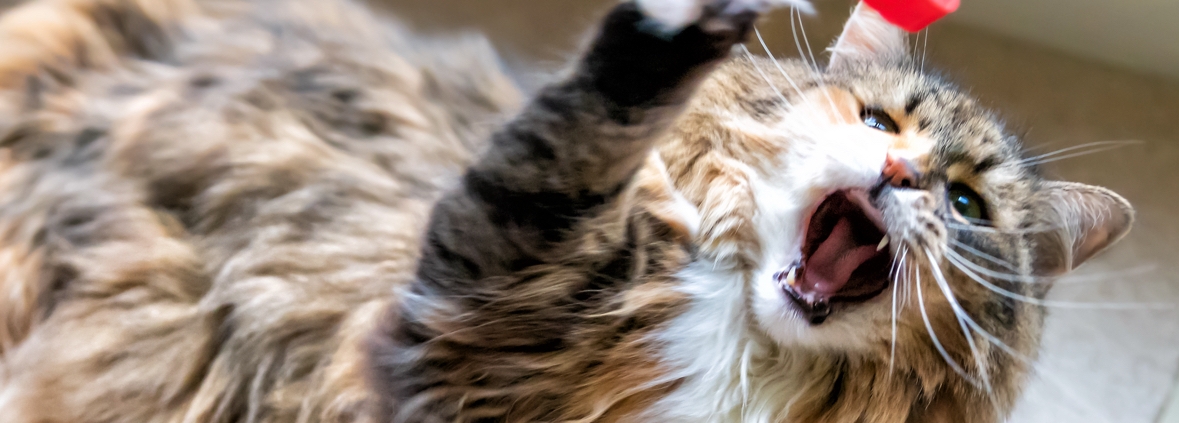Simple Home Adjustments to Help Cats With Arthritis
Simple Home Adjustments to Help Cats With Arthritis
Did you know that about 40% of cats show signs of arthritis, and more than 90% of cats over age 12 have arthritis changes visible on x-rays? Arthritis in cats can be tricky to spot, but the good news is there are lots of simple ways you can make life easier and more comfortable for your feline friend at home.
Here are some easy, practical modifications and enrichment ideas that can make a big difference for your cat with arthritis.
1. Toys That Encourage Gentle Play
Kicker toys are a great way to let your cat act on their natural hunting instincts while also keeping their back legs strong. These long, soft toys let your cat grab on with their front paws and “bunny kick” with their back legs. Try different types—plush, crinkly, catnip-filled—to see which your cat enjoys most.
2. Scratchers That Are Easy to Use
Scratching isn’t just about nails—it keeps your cat’s front legs strong and flexible. For cats with arthritis, horizontal scratchers or low wall-mounted ones are often easier than tall vertical posts.
3. The Comfort of a Cardboard Box
Boxes are still a favorite, even for senior cats. To make them arthritis-friendly, simply turn the box on its side or cut a low entry hole so your cat doesn’t have to climb over high edges. Instant, cozy den!
4. Litter Box Upgrades
If your cat is having accidents outside the litter box, it may be because getting in and out has become painful. Try:
- A box with at least one low side for easy entry.
- Placing boxes on every level of your home so stairs aren’t a barrier.
- Using a larger box if your cat struggles to posture comfortably.
5. Softer Surfaces = Easier Movement
Slippery floors can be intimidating for arthritic cats. Add rugs, yoga mats, or runners to help them move confidently.
Also, keep nails trimmed. Overgrown nails can make walking harder and even cause pain if they curl into paw pads.
6. Keep Essentials Within Reach
If stairs are a challenge, keep food, water, litter, and favorite beds or toys all on the same level. This reduces daily strain and makes your cat’s world easier to navigate.
7. Help Them Reach Their Favorite Spots
Cats love being up high, but jumping may no longer be an option. Provide ramps or pet steps to help them get to favorite windowsills, sofas, or beds. Adding a soft or heated bed makes these spots even more inviting.
8. Make Mealtime More Comfortable
Eating from bowls on the floor can strain sore joints. Raised food and water dishes bring meals up to a comfortable height and make feeding time more enjoyable.
Explore CARE Recommendations
We’ve gathered a curated list of products designed to help manage and care for your cat if you suspect, or have been given a diagnosis of OA. Be sure to always consult your vet and let them know everything you’ve taken note of. In the meantime, explore our suggested products on our CARE Shop page!
Final Thought
These small changes can make a big difference in your cat’s daily comfort, mobility, and happiness. With a little extra support, your cat can stay active, cozy, and content well into their golden years. Monique Koll, DVM, CCRP, CVPP: Certified Cat Friendly Veterinarian by the Feline Veterinary Medical Association
References
- For Cat Owners | Indoor Pet Initiative
- How to Make Your Arthritic Cat More Comfortable | Zoetis Petcare
- Slingerland LI, Hazewinkel HA, Meij BP, Picavet P, Voorhout G. Cross-sectional study of the prevalence and clinical features of osteoarthritis in 100 cats. Vet J. 2011 Mar;187(3):304-9. doi: 10.1016/j.tvjl.2009.12.014. Epub 2010 Jan 18. PMID: 20083417.
- Enomoto M, Lascelles BDX, Gruen ME. Development of a checklist for the detection of degenerative joint disease-associated pain in cats. J Feline Med Surg. 2020 Dec;22(12):1137-1147. doi: 10.1177/1098612X20907424. Epub 2020 Mar 3. PMID: 32122226; PMCID: PMC7736399.


